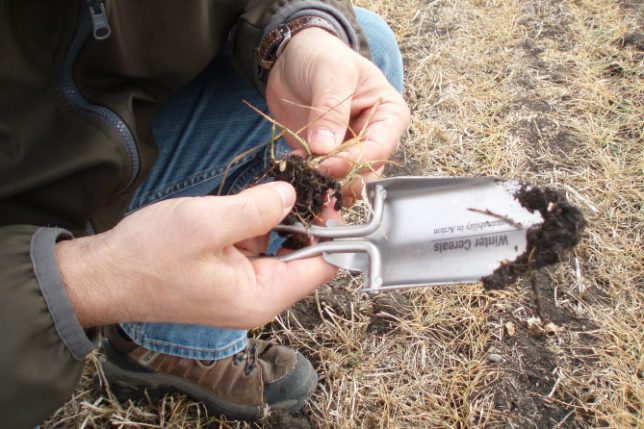There have been a lot of questions this winter about whether or not conditions were conducive for winter wheat survival. Did the crop get seeded too late in some cases? Was it too warm? Was there enough snow cover? Ken Gross, Western Winter Wheat Initiative (WWWI) agronomist, has fielded all those concerns, and more, this winter. His analysis? “It’s too early to make a call about winter wheat survivability. But I know guys are worrying, mainly because it’s the only crop they have to worry about, so of course, they will be concerned about it.”
Last fall, conditions made it very difficult to get winter wheat seeded in a timely fashion. “Harvest was very late in many cases,” explains Gross. “Very few fields were ready to seed in the first or second week of September.” As a result, winter wheat acreage is lower than average this year in both Manitoba and Saskatchewan. “On the positive side, the fields that did get seeded did get in in good shape,” he says. “Our surveys and observations showed the crop was very uniform with good establishment. Most was heading into winter in the 3-leaf stage.”
“The biggest issue I’m hearing about is the lack of snow cover,” says Gross. “I advise farmers that from December almost through February, winterkill occurs when soil temperature at the crown of the winter wheat plant gets to -200C or lower. If the crown is damaged or killed, then regrowth will be limited or non-existent. A good snow cover insulates the crown against the harsher temperatures we normally see through the winter.”
Manitoba Agriculture and Rural Development has soil temperature probes deployed in fields across the winter wheat growing areas of the province (Beausejour, St. Jean, Elphinstone and Grosse Isle). The coldest temperature recorded in most areas was -150C, so Gross is expecting good winter survivability this spring in Manitoba.
Because of all the questions being received, WWWI went a step further and dug up winter wheat plants March 16th and warmed the plants up. Regrowth occurred by March 18th with leaves and roots showing good vigour. “There are going to be those instances where it warmed up significantly – to the point where water was running,” says Gross. “If it then pooled and froze, there may be concerns, but those will be relatively small areas.” Agronomists in Saskatchewan targeted vulnerable areas, like hill tops, to assess plants, and everything they looked at grew well.
Night-time temperatures are the key. Once temperatures are consistently above 00C, winter wheat will break dormancy, and that’s when WWWI agronomists will really start monitoring fields for winterkill. “The forecast for the next two weeks is looking good,” says Gross. “If we get a -20 to -300C cold snap for four or five days, then its gloves off. But the weather models are just not showing that as a forecast.”
Gross also noted that farmers seeded large acres of Emerson winter wheat, switching from the traditional Falcon. “Emerson is not only rated R to fusarium head blight, it’s got much better winter hardiness as well.” says Gross. “My advice to growers is to wait until you are done at least 50 per cent of your spring seeding before evaluating the winter survivability of winter wheat.”
Although conditions did not seem ideal for winter wheat this winter with very low snow accumulations, the mitigating factor was the temperature – the winter wheat growing areas generally did not experience any long cold snaps that might have impacted the crop negatively otherwise.
Photo credit:
Digging up and examining winter wheat plants for winter survival. Photo courtesy of Ken Gross with Ducks Unlimited Canada.







Leave A Comment